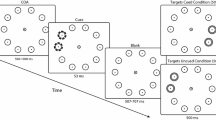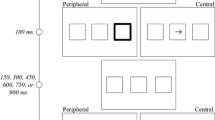Abstract
It has recently been demonstrated that there are independent sensory and motor mechanisms underlying inhibition of return (IOR) when measured with oculomotor responses (Wang et al. in Exp Brain Res 218:441–453, 2012). However, these results are seemingly in conflict with previous empirical results which led to the proposal that there are two mutually exclusive flavors of IOR (Taylor and Klein in J Exp Psychol Hum Percept Perform 26:1639–1656, 2000). The observed differences in empirical results across these studies and the theoretical frameworks that were proposed based on the results are likely due to differences in the experimental designs. The current experiments establish that the existence of additive sensory and motor contributions to IOR do not depend on target type, repeated spatiotopic stimulation, attentional control settings, or a temporal gap between fixation offset and cue onset, when measured with saccadic responses. Furthermore, our experiments show that the motor mechanism proposed by Wang et al. in Exp Brain Res 218:441–453, (2012) is likely restricted to the oculomotor system, since the additivity effect does not carry over into the manual response modality.



Similar content being viewed by others
Notes
Although in the M task the arrows (cue, cue back, and target) were all presented at fixation (repeated stimulation) and should thus also have evoked the sensory mechanism, this repeated stimulation is equated across cued and uncued trials and so does not contribute to the final IOR score.
An ANOVA was performed on the IOR scores, with the variables experiment (Experiment 1 vs. Experiment 2) and task (S, M′, or SM). The main effect of experiment did not reach significance (F(1, 34) = 0.1, p = 0.75, μ 2 G = 0.00), suggesting that the overall magnitude of IOR effects did not differ across the two experiments. The main effect of task did reach significance (F(2, 68) = 4.46, p < 0.05, μ 2 G = 0.05) but the interaction between task and experiment did not reach significance (F(2, 68) = 1.25, p = 0.29, μ 2 G = 0.02), suggesting that the overall pattern of results did not differ across the two experiments. However, separate ANOVAs performed for each experiment revealed a large effect of task for Experiment 1 (F(2, 22) = 7.82, p < 0.01, μ 2 G = 0.22) and a small effect for Experiment 2 (F(2, 46) = 1.18, p = 0.32, μ 2 G = 0.02), suggesting that, although we cannot assert so statistically, the difference in the pattern of results between Experiment 1 and Experiment 2 is likely a qualitative one.
Due to a programming lapse, in Experiments 3 and 4, the cue duration (and the overall CTOA) were extended on trials in which eye movements in response to cues occurred within 300 ms (29.2 % in Experiment 3 and 47.5 % in Experiment 4). As a result, in Experiment 3, the mean cue duration was 477 ms (mean CTOA = 1,625 ms) and 316 ms (mean CTOA = 1,513 ms) for exogenous and endogenous cue trials, respectively. In Experiment 4, the mean cue duration was 446 ms (mean CTOA = 1,648 ms) and 339 ms (mean CTOA = 1,542 ms) for exogenous and endogenous cue trials, respectively. We still report these two experiments because: (a) as will be shown in the Results sections, the SM task produced larger IOR effects despite the fact that the CTOA was longer in this task. The two causes theory of IOR predicts that the contribution of both the sensory and motor mechanisms to behavioral IOR decays with time. Consequently, the IOR effects in the SM tasks were slightly underestimated in Experiments 3 and 4. Nonetheless, IOR effects in the SM tasks were still larger than those for the M′ tasks in both experiments. (b) The pattern of results was essentially the same (i.e., stronger IOR for the SM task) in Experiment 3 when only trials not affected by the programming lapse were analyzed. IOR scores for the M′ and SM task were 19 ms and 44 ms in Experiment 3 (t(7) = 3.45, p < 0.05). In Experiment 4, only four participants produced enough normal trials (at least 6 trials per experimental cell) for such an analysis. The IOR effect for the SM task (60 ms) was still larger than that for the M′ task (31 ms) (t(4) = 2.95, p = 0.06) under these conditions.
References
Abrams RA, Dobkin RS (1994) The gap effect and inhibition return: interactive effects on eye movement latencies. Exp Brain Res 98:483–487
Anderson EJ, Rees G (2011) Neural correlates of spatial orienting in the human superior colliculus. J Neurophysiol 106:2273–2284
Dorris MC, Klein RM, Everling S, Munoz DP (2002) Contribution of the primate superior colliculus to inhibition of return. J Cogn Neurosci 14:1256–1263
Dukewich KR (2009) Reconceptualizing inhibition of return as habituation of the orienting response. Psychon Bull Rev 16:238–251
Dukewich KR, Boehnke S (2008) Cue repetition increases inhibition of return. Neurosci Lett 448:231–235
Fecteau JH, Munoz DP (2005) Correlates of capture of attention and inhibition of return across stages of visual processing. J Cogn Neurosci 17:1714–1727
Hilchey MD, Ivanoff J, Taylor TL, Klein RM (2011) The effect of inhibition of return on the temporal dynamics of spatial information processing. Acta Psychologica 136:235–244
Hilchey M, Klein RM, Satel J, Wang Z (2012) Oculomotor inhibition of return: how soon is it “recoded” into spatiotopic coordinates? Atten Percept Psychophys 74:1145–1153
Hooge IT, Frens MA (2000) Inhibition of saccade return (ISR): spatio-temporal properties of saccade programming. Vis Res 40:3415–3426
Hunt AR, Kingstone A (2003) Inhibition of return: dissociating attentional and oculomotor components. J Exp Psychol Hum Percept Perform 29:1068–1074
Klein RM, Macinnes JW (1999) Inhibition of return is a foraging facilitator in visual search. Psychol Sci 10:346–352
Klein RM (2000) Inhibition of return. Trends Cogn Sci 4:138–147
Masson M, Loftus G (2003) Using confidence intervals for graphically based data interpretation. Can J Exp Psychol 57:203–220
Mathôt S, Theeuwes J (2011) Gradual remapping results in early retinotopic and late spatiotopic inhibition of return. Psychol Sci 21:1793–1798
Maylor EA, Hockey R (1985) Inhibitory component of externally controlled covert orienting in visual space. J Exp Psychol Hum Percept Perform 11:777–787
Nagy A, Kruse W, Rottmann S, Dannenberg S, Hoffman K (2006) Somatosensory-motor neuronal activity in the superior colliculus of the primate. Neuron 52:525–534
Olejnik S, Algina J (2003) Generalized eta and omega squared statistics: measures of effect size for some common research designs. Psychol Methods 8:434–447
Pertzov Y, Zohary E, Avidan G (2011) Rapid formation of spatiotopic representations as revealed by inhibition of return. J Neurosci 30:8882–8887
Posner MI (1980) Orienting of attention. Q J Exp Psychol 32:3–25
Posner MI, Cohen Y (1984) Components of visual orienting. In: Bouma H, Bouwhuis DG (eds) Attention and performance. Hillsdale, NJ, London, pp 531–556
Posner MI, Rafal RD, Choate LS, Vaughan J (1985) Inhibition of return: neural basis and function. Cogn Neuropsychol 2:211–228
Prime DJ, Ward LM (2006) Cortical expressions of inhibition of return. Brain Res 1072:161–174
Saslow MG (1967) Effects of components of displacement-step stimuli upon latency of saccadic eye movements. J Opt Soc Am 57:1024–1029
Satel J, Wang Z, Trappenberg TP, Klein RM (2011) Modeling inhibition of return as short-term depression of early sensory input to the superior colliculus. Vis Res 51:987–996
Satel J, Wang Z, Hilchey MD, Klein RM (2012) Examining the dissociation of retinotopic and spatiotopic inhibition of return with event-related potentials. Neurosci Lett
Taylor TL, Klein RM (1998) On the causes and effects of inhibition of return. Psychon Bull Rev 5:625–643
Taylor TL, Klein RM (2000) Visual and motor effects in inhibition of return. J Exp Psychol Hum Percept Perform 26:1639–1656
Wang Z, Klein RM (2012) Focal spatial attention can eliminate inhibition of return. Psychon Bull Rev 19:462–469
Wang Z, Satel J, Trappenberg TP, Klein RM (2011) Aftereffects of saccades explored in a dynamic neural field model of the superior colliculus. J Eye Mov Res 4:1–16
Wang Z, Satel J, Klein RM (2012) Sensory and motor mechanisms of oculomotor inhibition of return. Exp Brain Res 218:441–453
Werner W, Dannenberg S, Hoffman K (1997) Arm-movement-related neurons in the primate superior colliculus and underlying reticular formation: comparison of neuronal activity with EMGs of muscles of the shoulder, arm and trunk during reaching. Exp Brain Res 115:191–205
Acknowledgments
This research was supported by Raymond M. Klein’s NSERC Discovery grant. We would like to thank Matthew D. Hilchey for continuing to challenge our interpretations and for helping us to design appropriate paradigms to continue testing our theoretical framework for IOR.
Author information
Authors and Affiliations
Corresponding author
Rights and permissions
About this article
Cite this article
Satel, J., Wang, Z. Investigating a two causes theory of inhibition of return. Exp Brain Res 223, 469–478 (2012). https://doi.org/10.1007/s00221-012-3274-6
Received:
Accepted:
Published:
Issue Date:
DOI: https://doi.org/10.1007/s00221-012-3274-6




